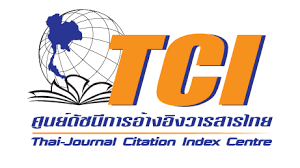ปุ๋ยหมักมูลไส้เดือนดิน : เทคโนโลยีชีววิถียุคดิจิทัลเพื่อการอนุรักษ์ดินและการจัดการขยะอินทรีย์ในประเทศไทย
คำสำคัญ:
เทคโนโลยีชีววิถี, ปุ๋ยหมักมูลไส้เดือนดิน, ขยะอินทรีย์, เป็นมิตรกับธรรมชาติบทคัดย่อ
ปุ๋ยมูลไส้เดือนดินนับเป็นนวัตกรรมในยุคดิจิตอลที่ถูกผลิตขึ้นจากวัสดุเหลือทิ้งทางการเกษตรและขยะอินทรีย์ จัดเป็นเทคโนโลยีที่ยั่งยืนในประเทศไทย เทคโนโลยีปุ๋ยมูลไส้เดือนดินนี้เกิดจากกระบวนการหมักวัสดุอินทรีย์ร่วมกับการทำงานของไส้เดือนดิน เช่น Eudrilus eugeniae ภายใต้สภาพมีอากาศ กระบวนการผลิตปุ๋ยมูลไส้เดือนดินมีข้อดีมากมาย เช่น เป็นกระบวนการที่เป็นมิตรกับสิ่งแวดล้อม ไม่มีสารพิษตกค้าง ต้นทุนต่ำ ใช้เครื่องมือไม่มากและหาได้ง่าย การจัดการดูแลไม่ยุ่งยาก พลังงานรวมที่ต้องใช้ในกระบวนการนี้น้อยมาก เป็นต้น ปุ๋ยมูลไส้เดือนดินช่วยในการปรับปรุงโครงสร้างทางฟิสิกส์ของดินที่เสียให้ดีขึ้นเหมาะต่อการปลูกพืชในประเทศที่กำลังพัฒนา ดังนั้นเทคโนโลยีปุ๋ยมูลไส้เดือนดินนี้จึงเป็นเทคโนโลยีทางเลือกอีกทางหนึ่งที่ทำง่าย ใช้วัสดุอินทรีย์ได้หลากหลายชนิด ความหลากหลายของสูตรปุ๋ย ทำให้ได้ชนิดวัสดุอินทรีย์ที่เหมาะสมกับคุณภาพของปุ๋ยและการใช้ประโยชน์กับพืชส่งเสริมให้ได้ธาตุอาหารที่จำเป็นปริมาณสูง ต่อการเจริญเติบโตและความแข็งแรงของต้นพืช กระตุ้นจุลินทรีย์ที่มีประโยชน์ให้เจริญได้ดี ช่วยสร้างฮอร์โมนที่จำเป็นแต่ละช่วงการเจริญเติบโตของพืช ไม่เพียงแค่ประโยชน์ในการผลิตปุ๋ย ปรับปรุงโครงสร้างดินให้ดีขึ้น หรือลดปริมาณขยะอินทรีย์ วัสดุเหลือทิ้งทางการเกษตรในประเทศเท่านั้น การใช้ปุ๋ยมูลไส้เดือนดินยังส่งเสริมเกษตรกรให้ผลิตพืชผักปลอดภัย ส่งผลต่อความปลอดภัยด้านสุขภาพของผู้ผลิต ผู้บริโภค และสิ่งแวดล้อม สนับสนุนการเป็นเกษตรกรยุคดิจิทัลเพื่อพัฒนาประเทศไทยต่อไปในอนาคต
References
Dominguez J. & Edwards C.A. (2004). Vermicomposting organic wastes: A review. In: Shakir Hanna S.H., Mikhail W.Z.A. (eds) Soil zoology for sustainable development in the 21st century., Cairo, pp.369-395.
Edwards C.A. and Bohlen P.J. (1996). Biology and Ecology of Earthworms. Third edition London: Chapman & Hall.
Edwards C.A. (2004). Earthworm ecology. Second edition The United States of America: CRC Press.
Edwards C.A., Arancon N.Q. & Sherman R. (2011). Vermiculture technology: Earthworms, organic wastes and environmental management. The United States of America: Taylor and Francis Group.
Gajalakshmi S., Ramasamy E.V. & Abbasi S.A. (2001). Assessment of sustainable vermiconversion of water hyacinth at different reactor efficiencies employing Eudrilus engeniae Kingburg. Bioresour Technol. 80,131–135.
Gajalakshmi S., Ramasamy E.V. & Abbasi S.A. (2002). Vermicomposting of paper waste with the anecic earthworm Lampito mauritii Kingburg. Indian J Chem Technol. 9, 306–311.
Gajalakshmi S. & Abbasi S.A. (2004). Earthworms and vermicomposting. Indian J. of Biotechnology. 3, 486-494.
Gopal M., Gupta A., Sunil E. & Thomas V.G. (2009). Amplifacation of plant beneficial microbial communities during conversion of coconut leaf substrate to vermicompost by Eudrilus sp. Current Microbiology. 59, 15-20.
Klangkongsub S. & Sohsalam P. (2013). Vermicompost production by using tomato residue and yard waste. Journal of Medical and Bioengineering. 2, 270-273.
Lazcano C., Gomez-Brandon M. & Dominguez J. (2008). Comparison of the effectiveness of composting and vermicomposting for the biological stabilization of cattle manure. Chemosphere. 72, 1013–1019.
Madsen E.L. & Alexander M. (1982). Transport of Rhizobium and Pseudomonas through soil. Soil Science Society of America. 46, 557-560.
Paoletti M.G., Faveretto M.R., Stinner B.R., Purrington F.F. & Bater J.E. (1991). Invertibrates as bioindicators of soil use. Agriculture Ecosystem Environment. 34, 341-362.
Pathma J. & Sakthivel N. (2012). Microbial diversity of vermicompost bacteria that exhibit useful agricultural traits and waste management potential. SpringerPlus. 26, 1-19.
Prasitket J., Chuvorrivate N., Ruengnab M., Padung T., Choulvanapong P. & Reanjareang S. (2005). Organic fertilizer: Production, utilization and quality. Department of Agriculture. pp.87.
Rouelle J. (1983). Introduction of an amoeba and Rhizobium Japonicum into the gut of Eisenia fetida (Sav.) and Lumbricus terrestris L. In: Satchel1 J.E. (ed) Earthworm Ecology: From Darwin to Vermiculture. NewYork: Chapman
and Hall.
Sailila N., Bakar A.A., Mahmood N.Z., Siliva J.T., Abdullah N. & Jamaludin. (2010). Nutrient elements of different agricultural wastes from vermicomposting activity. Dynamic Soil, Dynamic Plant. 4, 155-158.
Sharma, S., Pradham, K., Satya, S. & Vasudevan, P. (2005). Potentiality of earthworms for waste management and in other Use-A Review. Journal American Science. 1, 4-16.
Sinha, R.K., Agarwai, S., Chauhan, K. & Valani, D. (2010). The wonders of earthworms & its Vermicompost in farm production: Charles Darwin’s friends of farmers’ with potential to replace destructive chemical fertilizers from agriculture. Agricultural Sciences. 1, 76-94.
Sinha, R.K., Agarwal, S., Chauhan, K., Chandran, V. & Soni, B.K. (2010). Vermiculture technology: Reviving the dreams of Sir Charles Darwin for scientific use of earthworms in sustainable development programs. Technology and
Investment. 1, 155-172.
Tajbakhsh J, Abdoli MA, Mohammadi Goltapeh E, Alahdadi I, Malakouti MJ (2008). Trend of physico-chemical properties change in recycling spent mushroom compost through vermicomposting by epigeic earthworms Eisenia foetida
and E. And rei. J Agric Technol. 4, 185–198.
Tangsombatvichit P., Chupong S., Ketrot D. & Boonlerthirun K. (2016). The management of organic wastes produced vermicompost using earthworm Eudrilus eugeniae and effects of vermicompost on growth of Helianthus
annuus. 5th International conference on food, Agricultural and Biological Sciences (ICFABS-2016), Dec 25-26, 2016, Thailand.
Vaz-Moreira I., Maria E., Silva C.M., Manaia Olga C. & Nunes. (2008). Diversity of bacterial isolates from commercial and homemade composts. Microbial Ecology. 55, 714–722.
Yasir M., Aslam Z., Kim S.W., Lee S.W., Jeon C.O. & Chung Y.R. (2009). Bacterial community composition and chitinase gene diversity of vermicompost with antifungal activity. Bioresour Technol. 100, 4396–4403.
Zirbes, L., Renard, Q., Dufey, J., Tu, P.K., Duyet, H.N., Lebailly, P., Francis, F. & Haubruge, E. (2011). Valorisation of a water hyacinth in vermicomposting using an epigenic earthworm Perionyx excavatus in central Vietnam.
Biotechnol. Agron. Soc. Environ. 15, 85-93.
Downloads
เผยแพร่แล้ว
ฉบับ
บท
License
โปรดกรอกเอกสารและลงนาม "หนังสือรับรองให้ตีพิมพ์บทความในวารสารวิจัยมหาวิทยาลัยราชภัฏพระนคร สาขาวิทยาศาสตร์และเทคโนโลยี" ก่อนการตีพิมพ์



